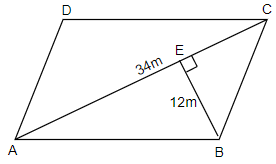Answer
408.9k+ views
Hint: In order to solve this question, we will first visualize the given condition and draw the figure accordingly. We need to remember that the diagonal of a parallelogram divides it in 2 congruent triangles. Also, we need to remember that the area of a triangle is given by the formula, $\dfrac{1}{2}$ (base) (height). By using these concepts we will solve this question.
Complete step-by-step answer:
In this question, we have been asked to find the area of a parallelogram ABCD, whose diagonal AC measures 34 m and the perpendicular distance of AC from either of the vertices B and D is 12 m. To solve this question, we will first consider the given situation and draw the figure accordingly. So, we get,

Here, we have considered E as the point of intersection of the perpendicular drawn from B on AC. So, according to the question, we can say that BE = 12 m.
Now, we know that the diagonal of a parallelogram divides it in 2 congruent triangles. So, we can say that,
Area of triangle ABC = Area of triangle ACD
Now, we know that the area of the parallelogram ABCD can be given as,
Area of triangle ABC + Area of triangle ACD
As we know that both the triangles are congruent, their areas will be the same, so we can further write the above expression as,
2 Area of triangle ABC
Now, we know that the area of the triangle = $\dfrac{1}{2}$ (base) (height). So, for triangle ABC, we can say that, area of triangle ABC = $\dfrac{1}{2}\times AC\times BE$. Therefore, we can write the area of parallelogram ABCD as,
$\begin{align}
& 2\times \dfrac{1}{2}\times AC\times BE \\
& AC\times BE \\
\end{align}$
Now, we will put the values of AC and BE, that are, AC = 34 m and BE = 12 m. So, we get the area of the parallelogram ABCD as,
$\begin{align}
& 34\times 12{{m}^{2}} \\
& 408{{m}^{2}} \\
\end{align}$
Therefore, we get the area of the parallelogram ABCD as $408{{m}^{2}}$. Hence option (b) is the correct answer.
Note: While solving the question, the possible mistakes we can make is by forgetting to multiply the area of the triangle by 2, to get the area of the parallelogram ABCD. So, we will choose the wrong answer. So, we have to be very careful while solving this question.
Complete step-by-step answer:
In this question, we have been asked to find the area of a parallelogram ABCD, whose diagonal AC measures 34 m and the perpendicular distance of AC from either of the vertices B and D is 12 m. To solve this question, we will first consider the given situation and draw the figure accordingly. So, we get,

Here, we have considered E as the point of intersection of the perpendicular drawn from B on AC. So, according to the question, we can say that BE = 12 m.
Now, we know that the diagonal of a parallelogram divides it in 2 congruent triangles. So, we can say that,
Area of triangle ABC = Area of triangle ACD
Now, we know that the area of the parallelogram ABCD can be given as,
Area of triangle ABC + Area of triangle ACD
As we know that both the triangles are congruent, their areas will be the same, so we can further write the above expression as,
2 Area of triangle ABC
Now, we know that the area of the triangle = $\dfrac{1}{2}$ (base) (height). So, for triangle ABC, we can say that, area of triangle ABC = $\dfrac{1}{2}\times AC\times BE$. Therefore, we can write the area of parallelogram ABCD as,
$\begin{align}
& 2\times \dfrac{1}{2}\times AC\times BE \\
& AC\times BE \\
\end{align}$
Now, we will put the values of AC and BE, that are, AC = 34 m and BE = 12 m. So, we get the area of the parallelogram ABCD as,
$\begin{align}
& 34\times 12{{m}^{2}} \\
& 408{{m}^{2}} \\
\end{align}$
Therefore, we get the area of the parallelogram ABCD as $408{{m}^{2}}$. Hence option (b) is the correct answer.
Note: While solving the question, the possible mistakes we can make is by forgetting to multiply the area of the triangle by 2, to get the area of the parallelogram ABCD. So, we will choose the wrong answer. So, we have to be very careful while solving this question.
Recently Updated Pages
The branch of science which deals with nature and natural class 10 physics CBSE

The Equation xxx + 2 is Satisfied when x is Equal to Class 10 Maths

Define absolute refractive index of a medium

Find out what do the algal bloom and redtides sign class 10 biology CBSE

Prove that the function fleft x right xn is continuous class 12 maths CBSE

Find the values of other five trigonometric functions class 10 maths CBSE

Trending doubts
Difference Between Plant Cell and Animal Cell

Difference between Prokaryotic cell and Eukaryotic class 11 biology CBSE

Fill the blanks with the suitable prepositions 1 The class 9 english CBSE

Change the following sentences into negative and interrogative class 10 english CBSE

Summary of the poem Where the Mind is Without Fear class 8 english CBSE

Give 10 examples for herbs , shrubs , climbers , creepers

Write an application to the principal requesting five class 10 english CBSE

What organs are located on the left side of your body class 11 biology CBSE

What is the z value for a 90 95 and 99 percent confidence class 11 maths CBSE



